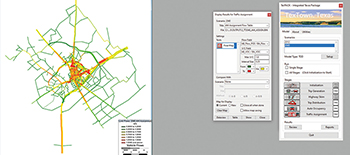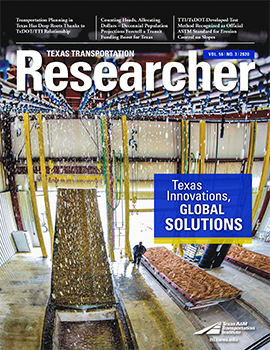A little known but decades-long relationship between the Texas Department of Transportation (TxDOT) and the Texas A&M Transportation Institute (TTI) has led to the development of a popular travel demand model application tool. The tool is the Texas Package Suite of Programs (simply known as TexPACK), and it’s receiving praise from transportation professionals across the state.

TexPACK is a computer software interface used by many of the state’s metropolitan planning organizations (MPOs) and TxDOT district planning offices. Transportation planners are embracing its user-friendly interface and newly added data visualization features. First developed for TxDOT in 2014, TexPACK helps planners tailor transportation demand models (TDMs) to the needs of their regions. A vital part of transportation planning since the 1950s, TDMs are used to forecast future travel demand for planning freeways, roadways, transit, and bicycle and pedestrian facilities. TDMs are derived from complicated mathematical equations and assumptions involving current and future population, households, employment, trips and numerous other variables.
“TexPACK is about six years old, but this latest version developed by TTI software engineers is wowing our customers and users,” says Bill Knowles, TxDOT’s traffic section director in the Transportation Planning and Programming Division. “TexPACK is helping unite our specialized community, especially with these recent improvements.” Knowles points out that the tool offers planners a single model application platform, creating a shared system for measuring and communicating results.

“TexPACK Version 2.5 simplifies the process and provides a common application platform for all uses in the state,” says Research Scientist Andy Mullins, manager of TTI’s Travel Forecasting Program. “TTI staff [led by Senior Research Scientist Kevin Hall and including Associate Research Scientist Shoupeng Tang, Assistant Research Scientists Hao Pang and John Murray, and Research Specialist V LD White] have assisted TxDOT with continuously improving the product, most recently with several substantial technical and results visualization enhancements. The latest of these were delivered within a month of being requested and ahead of the original development schedule.”
Hall explains that the latest version includes new trip generation software and an HTML-based model results tool. In one recent case, a contractor recommended that an MPO use TexPACK instead of having a customized version created by a contractor. “And that enthusiastic reception by transportation professionals is really growing,” explains Mullins.
“Travel demand models are part science and part art,” explains Chris Didear, branch manager, TxDOT Transportation Analysis System Support. “TTI accomplished both with TexPACK. The tool takes very complex modeling technology and simplifies it into an automated function so that users don’t have to worry about the formatting of inputs, manually processing model steps or calculation errors. And in our world, that is a big hurdle.”
Didear says the success of TexPACK shines a light on the transportation planning collaboration between TTI and TxDOT, which began 70 years ago when the Texas Highway Department first asked the Institute to help it create transportation planning models.
The partnership may not be well known since most people outside the transportation planning community don’t know about this unique aspect of the TxDOT/TTI relationship. As part of an interagency agreement (IAC) — and especially because the modeling has become ever more complicated — TTI offers a two-person help desk and in-person training to TxDOT and its regional and local planning partners. That same IAC expedited the creation of TexPACK and development of the subsequent, improved versions to date.
“We have identified improvements for future versions of the TexPACK tool several releases out and have a new release well underway,” Hall says. “Chances remain good that motorists won’t know about us or TexPACK. However, we do think they appreciate what the TexPACK software helps create — better transportation planning for the future. We are working to make that happen every day.”
